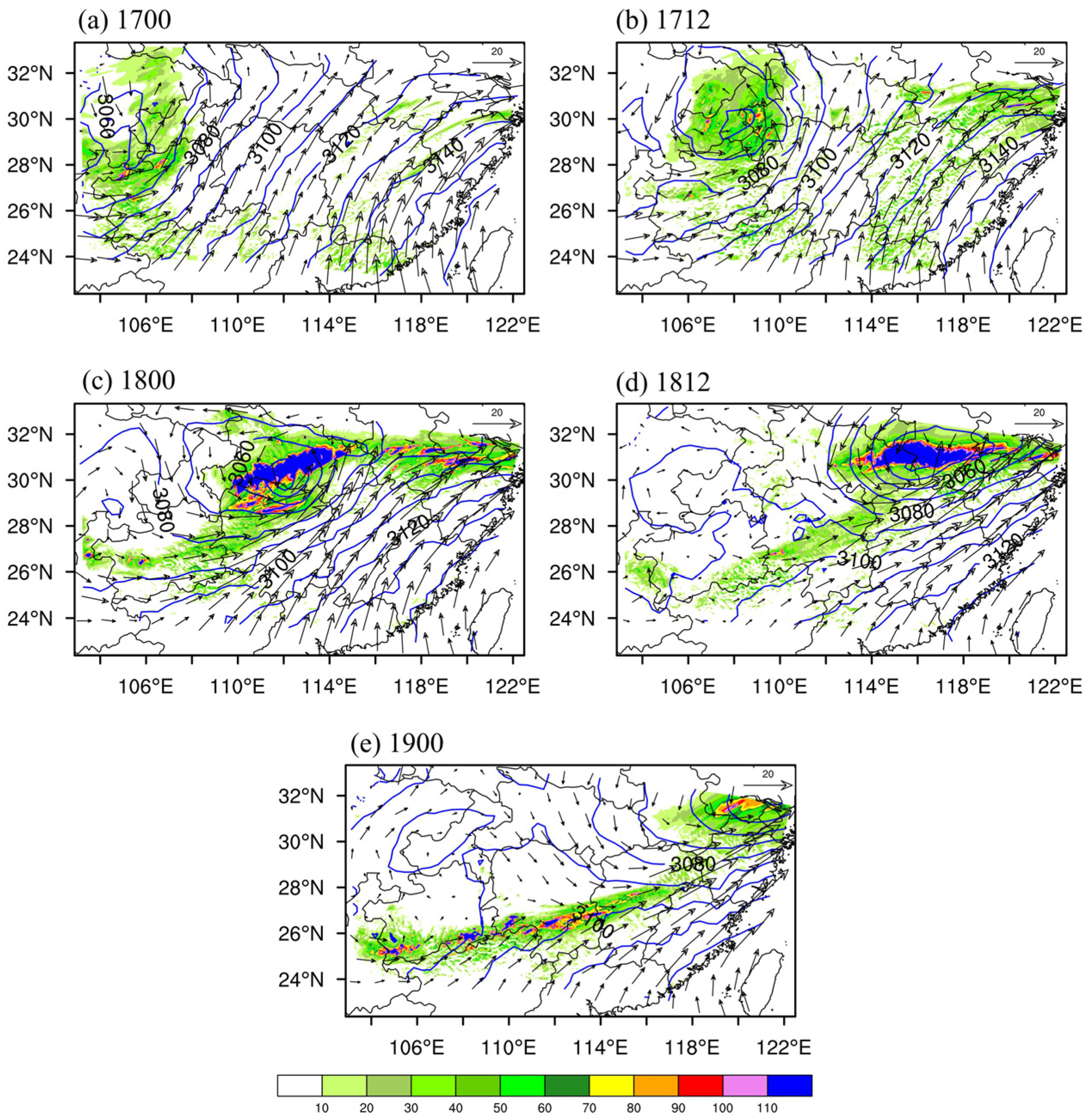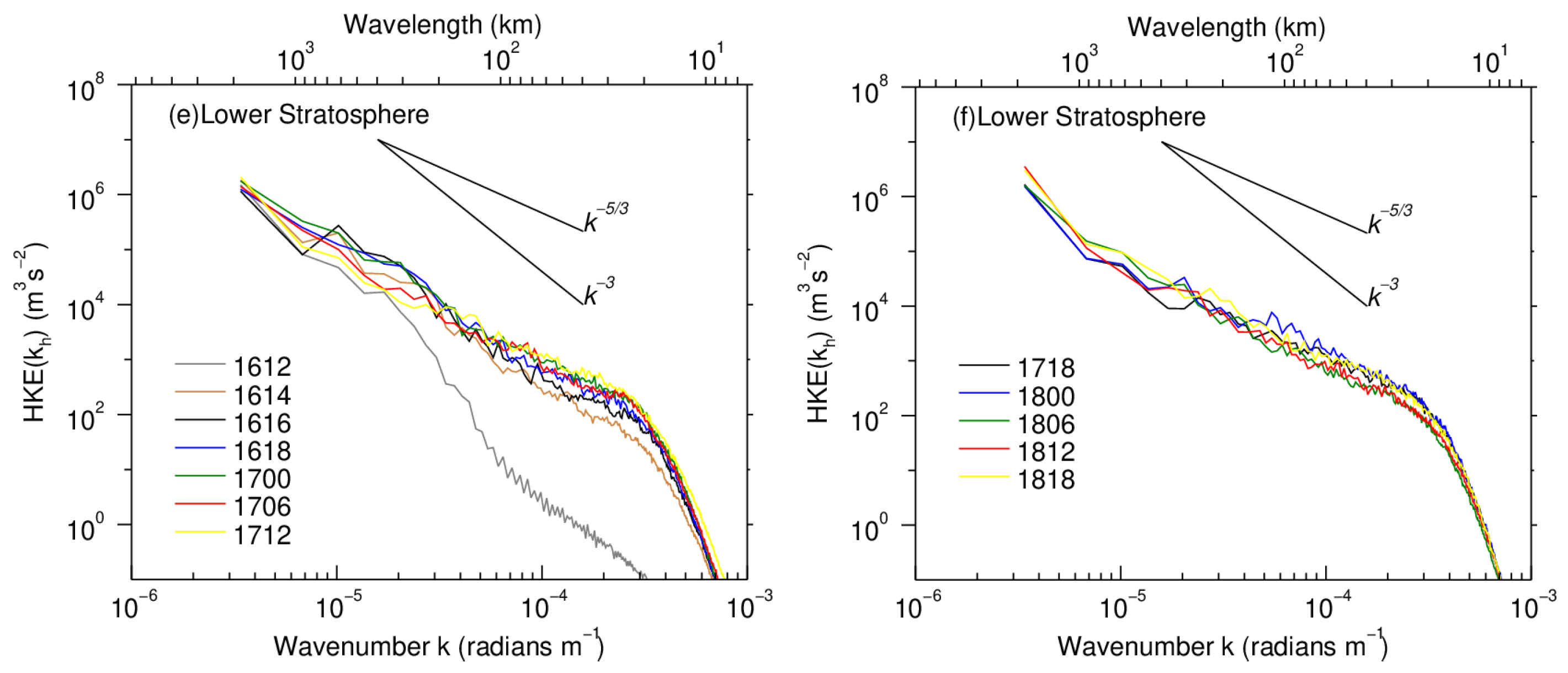Mesoscale Horizontal Kinetic Energy Spectra of an Eastward-Moving Southwest Vortex
Abstract
:1. Introduction
2. Numerical Simulation
2.1. Overview of the Southwest Vortex
2.2. Numerical Experiment
3. Analysis of Horizontal Kinetic Energy Spectra
3.1. The Mathematical Expressions for Horizontal Kinetic Energy
3.2. Evolutions of Horizontal Kinetic Energy Spectra
3.3. Rotational and Divergent Kinetic Energy Spectra
4. Discussion
5. Conclusions
Author Contributions
Funding
Institutional Review Board Statement
Informed Consent Statement
Data Availability Statement
Conflicts of Interest
References
- Zhang, S.; Li, C.; Bai, Y. Energy Analysis on a Heavy Storm Case in North China Caused by Typhoon No. 9406. Chin. J. Atmos. Sci. 2006, 30, 645–659. [Google Scholar]
- Yu, R.; Zhang, M.; Robert, D.C. Analysis of the atmospheric energy budget: A consistency study of available data sets. J. Geophys. Res. 1999, 104, 9655–9662. [Google Scholar] [CrossRef]
- Zheng, Y.; Jin, Z.; Chen, D. Kinetic energy spectrum analysis in a semi-implicit semi-Lagrangian dynamical framework. Acta Meteorol. Sin. 2008, 66, 143–157. [Google Scholar]
- Bierdel, L.; Friederichs, P.; Bentzien, S. Spatial kinetic energy spectra in the convection-permitting limited-area NWP model COSMO-DE. Meteorol. Z. 2012, 21, 245–258. [Google Scholar] [CrossRef]
- Larsen, M.F.; Kelly, M.C.; Gage, K.S. Turbulence spectra in the upper troposphere and lower stratosphere between 2 hours and 40 days. J. Atmos. Sci. 1982, 39, 1035–1041. [Google Scholar]
- Wang, Q.; Tan, Z. Multi-scale topographic control of southwest vortex formation in Tibetan Plateau region in an idealized simulation. J. Geophys. Res. Atmos. 2014, 119, 11543–11561. [Google Scholar] [CrossRef]
- Nastrom, G.D.; Gage, K.S. A Climatology of Atmospheric Wavenumber Spectra of Wind and Temperature Observed by Commercial Aircraft. J. Atmos. Sci. 1985, 42, 950–960. [Google Scholar] [CrossRef] [Green Version]
- Cho, J.Y.N.; Lindborg, E. Horizontal velocity structure functions in the upper troposphere and lower stratosphere: 1. Observations. J. Geophys. Res. Atmos. 2001, 106, 10223–10232. [Google Scholar] [CrossRef]
- Dewan, E.M. Stratospheric wave spectra resembling turbulence. Science 1979, 204, 832–835. [Google Scholar] [CrossRef]
- Gage, K.S. Evidence for a k−5/3 law inertial range in mesoscale two-dimensional turbulence. J. Atmos. Sci. 1979, 36, 1950–1954. [Google Scholar] [CrossRef] [Green Version]
- Tung, K.K.; Orlando, W.W. The k−3 and k−5/3 energy spectrum of atmospheric turbulence: Quasigeostrophic two-level model simulation. J. Atmos. Sci. 2003, 60, 824–835. [Google Scholar] [CrossRef] [Green Version]
- Tulloch, R.; Smith, K.S. Quasigeostrophic Turbulence with Explicit Surface Dynamics: Application to the Atmospheric Energy Spectrum. J. Atmos. Sci. 2009, 66, 450–467. [Google Scholar] [CrossRef]
- Lindborg, E. The energy cascade in a strongly stratified fluid. J. Fluid Mech. 2006, 550, 207–242. [Google Scholar] [CrossRef]
- Kolmogorov, A.N. The local structure of turbulence in incompressible viscous fluid for very large Reynolds number. Dokl. Akad. Nauk SSSR 1941, 30, 301–305. [Google Scholar]
- Koch, S.E.; Jamison, D.B.; Lu, C.; Smith, T.L.; Tollerud, E.I.; Girz, C.; Wang, N.; Lane, T.P.; Shapiro, M.A.; Parrish, D.D.; et al. Turbulence and gravity waves within an upper-level front. J. Atmos. Sci. 2005, 62, 3885–3908. [Google Scholar] [CrossRef]
- Lu, C.; Koch, S.E. Interaction of upper-tropospheric turbulence and gravity waves as obtained from spectral and structure function analyses. J. Atmos. Sci. 2008, 65, 2676–2690. [Google Scholar] [CrossRef]
- Lilly, D.K. Stratified Turbulence and the Mesoscale Variability of the Atmosphere. J. Atmos. Sci. 1983, 40, 749–761. [Google Scholar] [CrossRef] [Green Version]
- Koshyk, J.N.; Hamilton, K. The horizontal kinetic energy spectrum and spectral budget simulated by a high-resolution troposphere-stratosphere-mesosphere GCM. J. Atmos. Sci. 2001, 58, 329–348. [Google Scholar] [CrossRef] [Green Version]
- Skamarock, W.C. Evaluating Mesoscale NWP Models Using Kinetic Energy Spectra. Mon. Weather Rev. 2004, 132, 3019–3032. [Google Scholar] [CrossRef]
- Waite, M.L.; Snyder, C. The mesoscale kinetic energy spectrum of a baroclinic life cycle. J. Atmos. Sci. 2009, 66, 883–901. [Google Scholar] [CrossRef]
- Waite, M.L.; Snyder, C. Mesoscale energy spectra of moist baroclinic waves. J. Atmos. Sci. 2013, 70, 1242–1256. [Google Scholar] [CrossRef] [Green Version]
- Peng, J.; Zhang, L.; Zhang, Y. On the Local Available Energetics in a Moist Compressible Atmosphere. J. Atmos. Sci. 2015, 72, 1551–1561. [Google Scholar] [CrossRef]
- Peng, J.; Zhang, L.; Guan, J. Applications of a Moist Nonhydrostatic Formulation of the Spectral Energy Budget to Baroclinic Waves. Part II: The Upper-Tropospheric Energy Spectra. J. Atmos. Sci. 2015, 72, 3923–3939. [Google Scholar] [CrossRef]
- Peng, J.; Zhang, L.; Luo, Y.; Zhang, Y. Mesoscale Energy Spectra of the Mei-Yu Front System. Part I: Kinetic Energy Spectra. J. Atmos. Sci. 2014, 71, 37–55. [Google Scholar] [CrossRef]
- Sun, Y.Q.; Rotunno, R.; Zhang, F. Contributions of moist convection and internal gravity waves to building the atmospheric −5/3 kinetic energy spectra. J. Atmos. Sci. 2017, 74, 185–201. [Google Scholar] [CrossRef] [Green Version]
- Wang, Y.; Zhang, L.; Peng, J.; Liu, S. Mesoscale horizontal kinetic energy spectra of a tropical cyclone. J. Atmos. Sci. 2018, 75, 3579–3596. [Google Scholar] [CrossRef]
- Sun, Y.; Zhang, F. Intrinsic versus practical limits of atmospheric predictability and the significance of the butterfly effect. J. Atmos. Sci. 2016, 73, 1419–1438. [Google Scholar] [CrossRef] [Green Version]
- Hamilton, K.; Takahashi, Y.O.; Ohfuchi, W. Mesoscale spectrum of atmospheric motions investigated in a very fine resolution global general circulation model. J. Geophys. Res. Atmos. 2008, 113, D18110. [Google Scholar] [CrossRef]
- Mlawer, E.J.; Taubman, S.J.; Brown, P.D.; Iacono, M.J.; Clough, S.A. Radiative transfer for inhomogeneous atmospheres: RRTM, a validated correlated-k model for the longwave. J. Geophys. Res. Atmos. 1997, 102, 16663–16682. [Google Scholar] [CrossRef] [Green Version]
- Dudhia, J. Numerical study of convection observed during the winter monsoon experiment using a mesoscale two-dimensional model. J. Atmos. Sci. 1989, 46, 3077–3107. [Google Scholar] [CrossRef]
- Kain, J.S.; Fritsch, J.M. A one-dimensional entraining/detraining plume model and its application in convective parameterization. J. Atmos. Sci. 1990, 47, 2784–2802. [Google Scholar] [CrossRef] [Green Version]
- Wernli, H.; Paulat, M.; Hagen, M.; Frei, C. SAL—A novel quality measure for the verification of quantitative precipitation forecasts. Mon. Weather Rev. 2008, 136, 4470–4487. [Google Scholar] [CrossRef] [Green Version]
- Boer, G.J.; Shepherd, T.G. Large-Scale Two-Dimensional Turbulence in the Atmosphere. J. Atmos. Sci. 1982, 40, 164–184. [Google Scholar] [CrossRef] [Green Version]
- Zheng, H.; Zhang, Y.; Wang, Y.; Zhang, L.; Peng, J.; Liu, S.; Li, A. Characteristics of Atmospheric Kinetic Energy Spectra during the Intensification of Typhoon Lekima (2019). Appl. Sci. 2020, 10, 6029. [Google Scholar] [CrossRef]
- Lindborg, E. Horizontal Wavenumber Spectra of Vertical Vorticity and Horizontal Divergence in the Upper Troposphere and Lower Stratosphere. J. Atmos. Sci. 2007, 64, 1017–1025. [Google Scholar] [CrossRef]
- Kim, S.Y.; Chun, H.Y. Stratospheric gravity waves generated by Typhoon Saomai (2006): Numerical modeling in a moving frame following the typhoon. J. Atmos. Sci. 2010, 67, 3617–3636. [Google Scholar] [CrossRef]
- Yu, S.; Zhang, L.; Zhang, M.; Wang, Y. Dynamics of Mechanical Oscillator Mechanism for Stratospheric Gravity Waves Generated by Convection. Atmosphere 2020, 11, 942. [Google Scholar] [CrossRef]









Publisher’s Note: MDPI stays neutral with regard to jurisdictional claims in published maps and institutional affiliations. |
© 2022 by the authors. Licensee MDPI, Basel, Switzerland. This article is an open access article distributed under the terms and conditions of the Creative Commons Attribution (CC BY) license (https://creativecommons.org/licenses/by/4.0/).
Share and Cite
Yu, S.; Zhang, L.; Wang, Y.; Peng, J. Mesoscale Horizontal Kinetic Energy Spectra of an Eastward-Moving Southwest Vortex. Atmosphere 2022, 13, 653. https://doi.org/10.3390/atmos13050653
Yu S, Zhang L, Wang Y, Peng J. Mesoscale Horizontal Kinetic Energy Spectra of an Eastward-Moving Southwest Vortex. Atmosphere. 2022; 13(5):653. https://doi.org/10.3390/atmos13050653
Chicago/Turabian StyleYu, Shiwang, Lifeng Zhang, Yuan Wang, and Jun Peng. 2022. "Mesoscale Horizontal Kinetic Energy Spectra of an Eastward-Moving Southwest Vortex" Atmosphere 13, no. 5: 653. https://doi.org/10.3390/atmos13050653
APA StyleYu, S., Zhang, L., Wang, Y., & Peng, J. (2022). Mesoscale Horizontal Kinetic Energy Spectra of an Eastward-Moving Southwest Vortex. Atmosphere, 13(5), 653. https://doi.org/10.3390/atmos13050653





